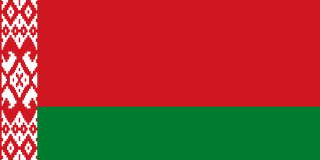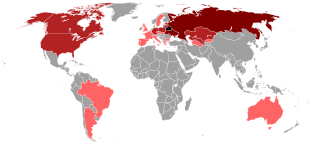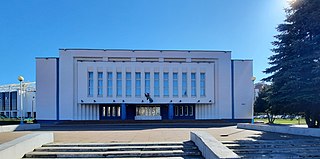
Belarus, officially the Republic of Belarus, is a landlocked country in Eastern Europe. It is bordered by Russia to the east and northeast, Ukraine to the south, Poland to the west, and Lithuania and Latvia to the northwest. Belarus spans an area of 207,600 square kilometres (80,200 sq mi) with a population of 9.1 million. The country has a hemiboreal climate and is administratively divided into six regions. Minsk is the capital and largest city; it is administered separately as a city with special status.

Belarusians are an East Slavic ethnic group native to Belarus. They natively speak Belarusian, an East Slavic language. More than 9 million people proclaim Belarusian ethnicity worldwide. Nearly 7.99 million Belarusians reside in Belarus, with the United States and Russia being home to more than 500,000 Belarusians each. The majority of Belarusians adhere to Eastern Orthodoxy.
The lands of Belarus during the Middle Ages became part of Kievan Rus' and were split between different regional principalities, including Polotsk, Turov, Vitebsk, and others. Following the Mongol invasions of the 13th century, these lands were absorbed by the Grand Duchy of Lithuania, which later was merged into the Polish–Lithuanian Commonwealth in the 16th century.

Polotsk or Polatsk is a town in Vitebsk Region, Belarus. It is situated on the Dvina River and serves as the administrative center of Polotsk District. Polotsk is served by Polotsk Airport and Borovitsy air base. As of 2024, it has a population of 79,579.

Vitebsk Region, also known as Vitebsk Oblast or Vitsyebsk Voblasts, is one of the regions of Belarus. Its administrative center is Vitebsk. It is located in the north of the country, and borders on Russia.

The national emblem of Belarus features a ribbon in the colors of the national flag, a silhouette of Belarus, wheat ears and a red star. It is sometimes referred to as the coat of arms of Belarus, although in heraldic terms this is inaccurate as the emblem does not respect the rules of conventional heraldry. The emblem is an allusion to one that was used by the Byelorussian SSR, designed by Ivan Dubasov in 1950, with the biggest change being a replacement of the Communist hammer and sickle with a silhouette of Belarus. The Belarusian name is Dziaržaŭny hierb Respubliki Biełaruś, and the name in Russian is Gosudarstvennyĭ gerb Respubliki Belarusʹ.

At the top level of administration, Belarus is divided into six regions and one capital city. The six regions are oblasts, while the city of Minsk has a special status as the capital of Belarus. Minsk also serves as the administrative center of Minsk Region.

Belarus is an Eastern European country with a rich tradition of folk and religious music. The country's folk music traditions can be traced back to the times of the Grand Duchy of Lithuania. The country's musical traditions spread with its people to countries like Russia, Canada, United States, Kazakhstan and Latvia. The people of Belarus were exposed mostly to Russian pop music during this period and also after independence in 1991. In 2002, however, President Alexander Lukashenko has signed a decree requiring 50% of all FM broadcast music to be Belarusian in origin, and since 1 January 2005 the rule has been even stricter. However, it does not regulate the language of the songs, so most of the music which is broadcast is still in Russian.

Novopolotsk or Navapolatsk is a city in Vitebsk Oblast, Belarus. Founded in 1958, it is located close to the city of Polotsk and the name literally means "New Polotsk". In 2008, its population was 107,458. As of 2024, it has a population of 95,717.

Belarusian culture is the product of a millennium of development under the impact of a number of diverse factors. These include the physical environment; the ethnographic background of Belarusians ; the paganism of the early settlers and their hosts; Eastern Orthodox Christianity as a link to the Byzantine literary and cultural traditions; the country's lack of natural borders; the flow of rivers toward both the Black Sea and the Baltic Sea; and the variety of religions in the region.

The National Academy of Sciences of Belarus is the national academy of Belarus.
The uses of heraldry in Belarus is used by government bodies, subdivisions of the national government, organizations, corporations and by families.

The International Festival of Arts "Slavianski Bazaar in Vitebsk", also known as Slavic Bazaar, is an annual festival held in Vitebsk, Belarus under the auspices of the Belarusian Government since 1992. Its main program is devoted to Slavic music. The main participants are artists from Russia, Belarus, Ukraine, countries of the former Yugoslavia, Poland, and Bulgaria with guests from many other countries, both Slavic and non-Slavic.

Vitebsk Central Sport Complex is a multi-use sports complex in Vitebsk, Belarus. It is currently used mostly for football matches and is the home ground of FC Vitebsk. The stadium holds 8,144 people.

The following outline is provided as an overview of and topical guide to Belarus:

Vitebsk Museum of Modern Art was an art museum in Vitebsk, Belarus organized in 1918 by Marc Chagall, Kazimir Malevich and Alexander Romm. In 1921, it exhibited 120 paintings "representing all the movements of the contemporary art from the Academic Realism to Impressionism to Suprematism". In the mid-1920s, the museum was closed. While some paintings have found their way to museums of Russia and Belarus, the whereabouts of many paintings are unknown.
The Belarusian history within the Russian Empire is associated with the history of Belarus from the Partitions of the Polish–Lithuanian Commonwealth to the October Revolution when the present-day Belarus' lands were made part of the Russian Empire.

The cultural heritage of Belarus includes both material and immaterial assets (valuables), in accordance with the Law on Protection of Historical and Cultural Heritage of the Republic of Belarus (2006).

Alex Salaueu was a Belarusian Avant-garde artist. Few works have survived from his extensive artistic repertoire, estimated at nearly 5000 creations. The majority of his work, especially his lyrical abstract works, stem from the latter part of his career. The latest are held by museums and discerning collectors. Salaueu was a Member of the Union of Artists of the Republic of Belarus and an Honored Artist of the Byelorussian SSR (1982).

Viktar Mikalayevich Dashkevich was a Belarusian stage actor.














